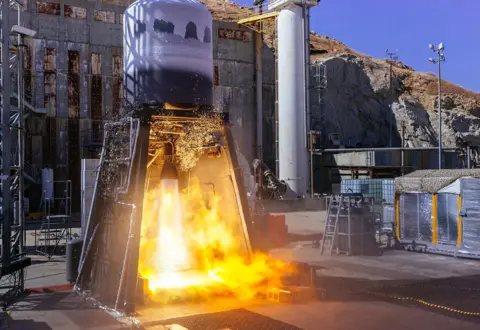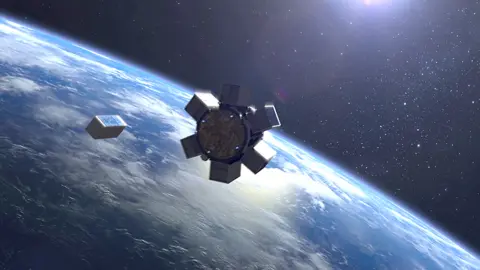Lockheed Martin selects ABL rocket for Shetland launches

Aerospace giant Lockheed Martin has selected the rocket it will use to kick-start space launches from the island of Unst in Shetland.
The vehicle, called the RS1, will be provided by ABL Space Systems of El Segundo, California.
If everything comes together, an inaugural flight could occur next year.
Lockheed is looking to stimulate the launch business in the UK to take advantage of a rapidly expanding market for small satellites.
These spacecraft, many no bigger than a shoebox, are all seeking more flexible and affordable ways of getting into orbit, and Lockheed believes it's putting together an attractive package.
"What we're trying to do here is establish an infrastructure," said UK regional director Nik Smith.
"We won't ourselves be launching the rockets; we have a partner for that in ABL. And we won't operate a spaceport; we again have a partner for that in the Shetland Space Centre (SSC) in this case. But if we can establish the infrastructure, bringing in other business, we can then become a customer ourselves, hopefully on preferential terms," he told BBC News.
 ABL Space Systems
ABL Space SystemsLockheed was given £23.5m by the UK government in 2018 to advance plans for space launches in Britain.
At the time, the expectation was a "pathfinder" flight would take place from a launch facility on the A'Mhoine Peninsula in Sutherland, on the Scottish mainland, using perhaps a vehicle from the US-New Zealand operator Rocket Lab.
But last year, Lockheed switched its interest to Unst, and has now brought onboard ABL in which it also has a strategic investment.
The California start-up has yet to launch the RS1 even in the US. It's hoping to do this no later than June.
The 27m-tall (88ft) RS1 is a two-stage vehicle, burning kerosene and liquid oxygen. It should be able to put about a tonne of payload into a 500km-high, Sun-synchronous orbit - the type of polar orbit often favoured by Earth observation satellites, and which Unst is ideally placed to facilitate.
Being the most northerly island in Shetland, it will give the ascending rocket a clear and safe run northwards. Any failure would see debris fall harmlessly into the ocean.
What's particularly appealing about the RS1 is its mode of operation. ABL has conceived a "rocket in a box" concept.
"Our vehicle is simple, it's ruggedised, and it was built to be highly transportable," explained ABL CEO Harry O'Hanley. "The vehicle itself was actually sized to fit inside a shipping container; and all of the ground systems, like the fluid and electrical systems that you would conventionally see in a launch pad - they also will fit into shipping containers."
 Lockheed Martin
Lockheed MartinThe first Unst launch scheduled for 2022 would see the RS1 deploy a kind of "space tug" built by the Moog company in Reading. This tug will have the ability to trim the parameters of the orbit to optimally suit its satellite passengers.
There will be up to six of these. One berth is already taken by Orbital Micro Systems, which operates small weather satellites. From the conversations it's having with industry, Lockheed says it's confident all the other positions on the tug will be filled, too.
The rapid expansion of the small satellite market was highlighted in a 2020 report from the Bryce analytics and engineering consultancy. It estimated that there were 52 small satellites launched in 2012 (1% of the total mass of satellites launched into orbit), which increased to 389 small satellites in 2019 (11% of total mass).
And just last month, 143 small satellites - including some that were smaller than a paperback book - went up on a single rocket.
The UK ought to be a great place to launch satellites if for no other reason than it's where so many of these compact spacecraft are made. Indeed, Scotland, with the likes of AAC Clyde Space in Glasgow, has established itself as a global leader in this type of manufacturing.
ABL's CFO, Dan Piemont, told BBC News: "We're definitely excited about the idea of providing a European launch capability that's reliable and at a cadence where I think European satellite developers and other spacecraft developers will have at the very least the logistical preference to be launching from SSC."
But if Britain is to grab a serious share of the small sat launch business, it will need to move at an accelerated pace. Plenty of other countries are angling for their own slice of the pie.
Getting ahead means quickly establishing the physical infrastructure and putting in place the right regulatory framework.
For Unst, the planning application for the three-pad launch centre on the Lamba Ness peninsula is now with Shetland Islands Council. Approvals could come around May, which would then allow building work to get under way.
All launches from UK soil will also need to be licensed. This can't happen until secondary legislation following on from the Space Industry Act 2018 goes through parliament. Summertime would appear to be the timeline for this.
"We need to make sure that we harness what the space sector in the UK has to offer, to enable it to go and compete on the international stage. There's a real opportunity in all this to help the UK economically on a recovery basis," said Ian Annett, deputy CEO for programme delivery at the UK Space Agency.
Shetland has commitments from other rocket operators, in addition to Lockheed Martin's tie-up with ABL Space Systems.
C6 Launch Systems, a start-up from Ontario, Canada, has signed a letter of intent to use Unst. Likewise, HyImpulse Technologies from Germany.
And, of course, other locations in the UK continue to press forward with their plans. Sutherland's spaceport will be the base for the forthcoming Prime vehicle from Forres-based Orbex. Edinburgh-headquartered Skyrora will no doubt be looking for a Scottish launch pad for its future XL orbital-class vehicle.
While Newquay in Cornwall will host the air-launched rocket system developed by Sir Richard Branson's Virgin Orbit company.
